Numerical Simulation and Analysis of Excavation and Support in Traffic Tunnel of a Power Station*
ZHOU Weibo, LEI Ming, WANG Tao, SARHOSIS Vasilis
(1.Powerchina Northwest Engineering Co., Ltd., Xi’an,Shaanxi 710065, China;2.State Key Laboratory of Water Resources and Hydropower Engineering Science, Wuhan University, Wuhan,Hubei 430072, China;3.School of Civil Engineering, University of Leeds, Leeds LS29JT, U.K.)
Abstract: To evaluate the rationality of the excavation and support structure design in tunnel engineering, numerical simulation and structural deformation stability analysis in excavation and support in a traffic tunnel are carried out in combination with the practical geological conditions study. The computation results demonstrate that following excavation, the surrounding rock deforms minimally and has a large self-bearing capacity. The shotcrete-bolt structure in the initial support has small deformation and stress, ensuring that it meets the safety and stability requirements. The stress of the secondary lining structure is calculated, which can also meet the structural strength requirements. The traffic tunnel’s supporting system is a practical and cost-effective manner. The proposed study will provide a specific reference for the design and research of the support structures in traffic tunnels.
Keywords: undeground engineering;traffic tunnel;supports;deformation;force analysis
0 Introduction
With the large-scale construction of underground tunnel engineering and the continuous development of construction technology in China, shotcrete-bolt support technology has become a widely used construction method in tunnel and underground engineering. The actual constructions of the project often encounter a series of geological problems, such as fault fracture zones and weak structural planes, which pose significant construction challenges. tunnel excavation and support has always been a hot topic in the engineering field[1]. Scholars at home and abroad have also conducted extensive research on numerical simulation and construction technology of tunnel engineering support[2-6]. This paper focuses on the numerical calculation of force, deformation and stability of supporting structure and surrounding rock in the excavation and support construction process of a traffic tunnel. The computation results and analysis findings can provide a certain level of reference relevance for evaluating the rationality of supporting parameters selections.
1 Project profile
The hub buildings of a pumped storage power station are mainly composed of the upper and lower reservoir, flood discharge buildings, water conveyance system, underground powerhouse and switchyard. The connecting road of the upper and lower reservoir is an important traffic road connecting the upper and lower reservoir. The starting point of the road is connected with the external highway of the lower reservoir, and the ending point is connected with the top of the upper reservoir dam on the right bank. The total length of the road is 11.68km, and the section from the pile number K4 + 070—K4 + 417 is the traffic tunnel of the connection road between the upper and lower reservoir. The total length of the traffic tunnel is 347m, the entrance elevation of the traffic tunnel is 1, 885.45m, the exit elevation is 1, 898.82m, and the longitudinal slope is 3.85%. The traffic tunnel is designed as a single-hole with two-way traffic tunnel, which adopts the tertiary design standard in the hydropower field. The design speed is 20km/h, the traffic tunnel building boundary is 7.5m × 4.5m ( net width × net height ), and the inner contour is in the form of three-center circle. The average vertical buried depth of the traffic tunnel is about 40m, and the lithology is diabase. The surrounding rock type is mainly class Ⅲ and locally class Ⅳ. The traffic tunnel is designed according to the principle of New Austrian Tunneling Method. The composite support combines the initial shotcrete-bolt support with the secondary concrete lining. The designed parameters of the initial support of the traffic tunnel in class Ⅲ surrounding rock are as follows: the thickness of C20 shotcrete with hanging steel mesh is 10cm, the spacing ofφ6.5 steel mesh is 25cm×25cm,φ22 systematic bolts are set around the tunnel, the length of the bolts is 3m, the spacing is 1.5m × 1.5m, and the bolts are distributed in a quincunx shape. The secondary lining is made of C25 concrete with thickness of 35cm. The layout and typical supporting section of traffic tunnel are shown in Fig.1.

Table 1 Mechanical parameters of surrounding rock and supporting structure

Fig.1 Layout and typical supporting section of the traffic tunnel
2 Model building
Finite element analysis software is used to simulate the construction process of the traffic tunnel. Based on the drafted factors such as the size of tunnel lining structure, the buried depth of roof and rock classification, the tunnel section of class Ⅲ surrounding rock is selected as the typical calculation section. The left, right and lower boundaries of the calculation model are set at a distance more than 5 times the diameter of the two sides of the tunnel wall and bottom board, and the upper boundary is taken to the surface. The classification of surrounding rock types and calculation model are shown in Fig.2. This calculation involves a variety of grid elements such as strongly weathered diabase, weakly weathered diabase, lightly weathered diabase, secondary lining concrete, shotcrete and bolt, as well as the corresponding mechanical property parameters, which are selected as shown in Tab.1.
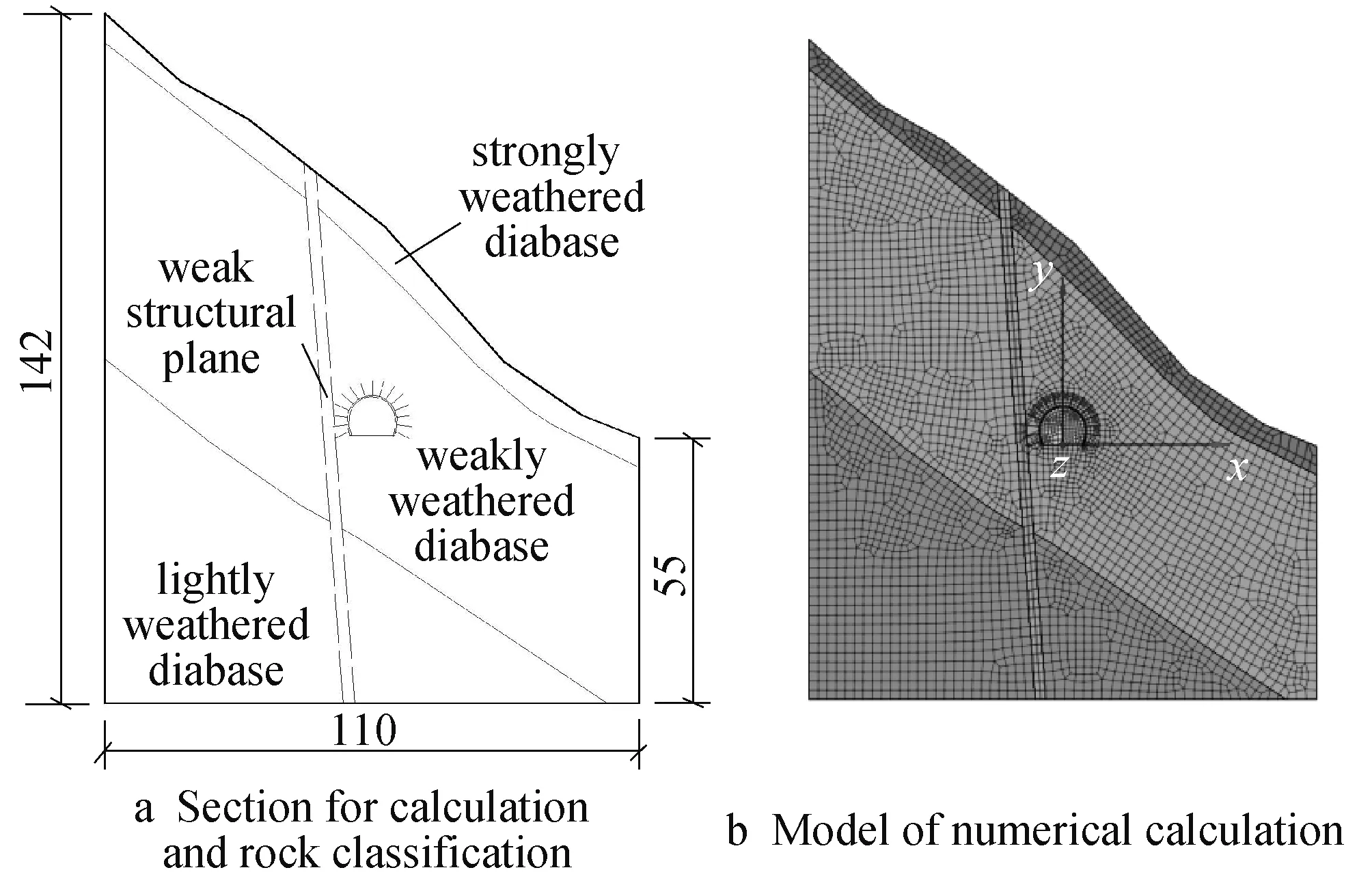
Fig.2 Calculation section and model of numerical analysis
3 Numerical calculation results and analysis
The calculation of the excavation and support of traffic tunnel mainly includes the calculation process of calculating initial stress field generation, excavation of traffic tunnel, initial shotcrete-bolt support and secondary lining support. In the simulation calculation of traffic tunnel excavation and construction process, the combined load release coefficient is used to simulate the spatial and temporal impacts of initial stress around the tunnel. The combined load release coefficient reflects the spatial action of the excavation surface and the influence of supporting time in each construction step. According to the relevant provisions ofGuidelinesforDesignofHighwayTunnel(JTG/T D70—2010)[7], the value of the combined load release coefficient in the excavation process is shown in Tab.2.

Table 2 The combined load release coefficient unit:%
3.1 Numerical calculation results
After excavation, the surrounding rock is displaced horizontally and vertically towards the traffic tunnel. The horizontal displacement mainly occurs at the left arch foot and the arch roof, with a maximum horizontal displacement of 0.394mm above the arch roof. The vertical displacement mainly occurs at the arch roof and the bottom plate, with a maximum vertical displacement of 1.31mm principally at the bottom plate. After the excavation of the traffic tunnel, the unloading rebound deformation of the arch roof and the bottom plate is the main deformation. As indicated Fig.3, the maximum overall displacement occurs at the bottom plate, which is 1.32mm. The weak structural plane on the left side of traffic tunnel has little influence on the stability of surrounding rock, and the deformation of traffic tunnel after excavation is very modest, meeting the deformation stability requirement of excavation.
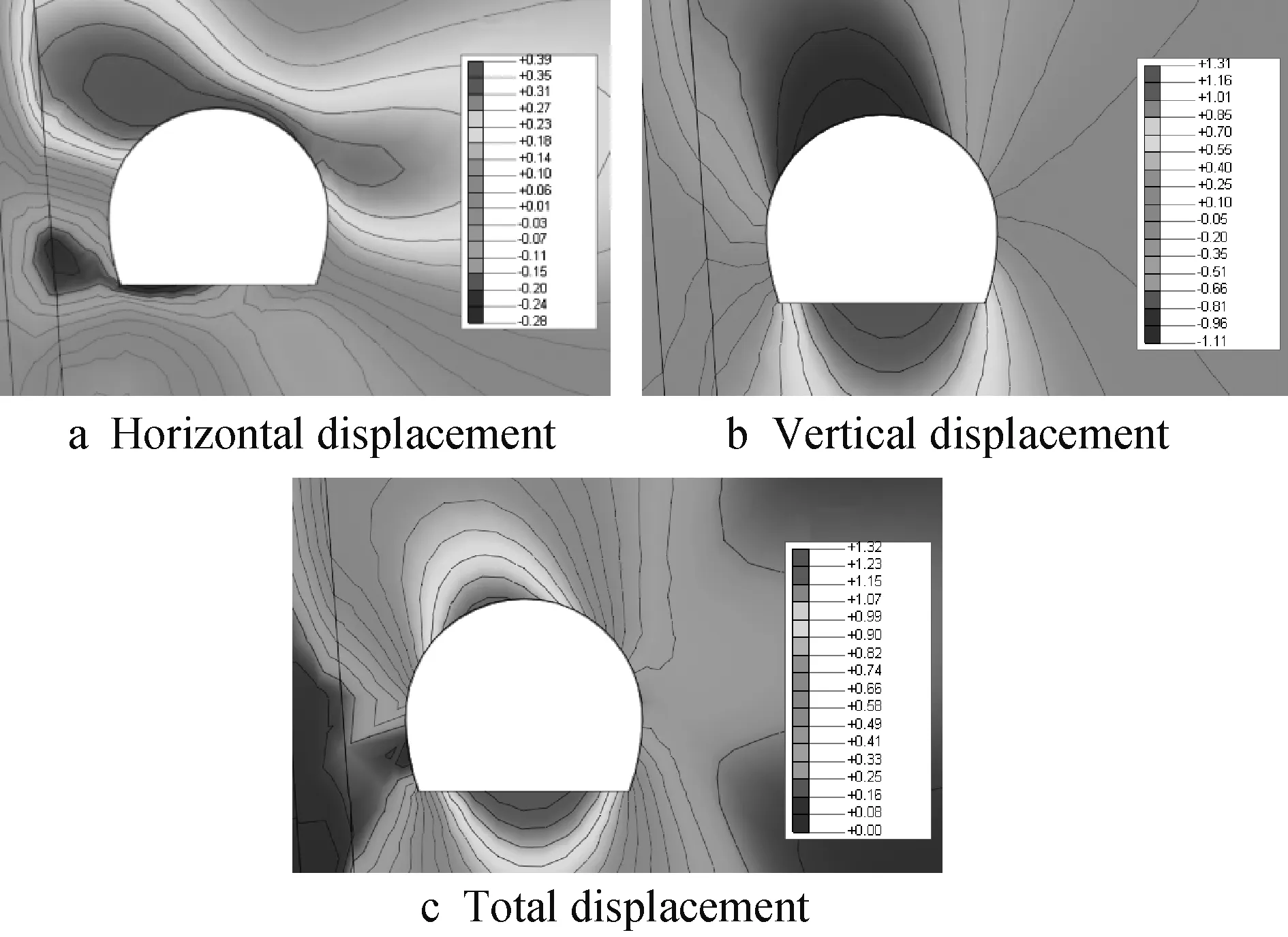
Fig.3 Displacement of surrounding rock
The maximum axial force of the shotcrete structure near the wall footing is -41.26kN with a bending moment of -1.56kN·m. The maximum bending moment is 1.56kN·m at about 0.2m above the wall footing, and the axial force is -41.17kN. Due to the action of the bolts, the bending moment value at the arch roof is small. The maximum bending moment is only -0.398kN·m (as shown in Fig.4). The bolts’maximum axial force is 5.2kN (as shown in Fig.5), which meets the bolts’design bearing capacity requirement.
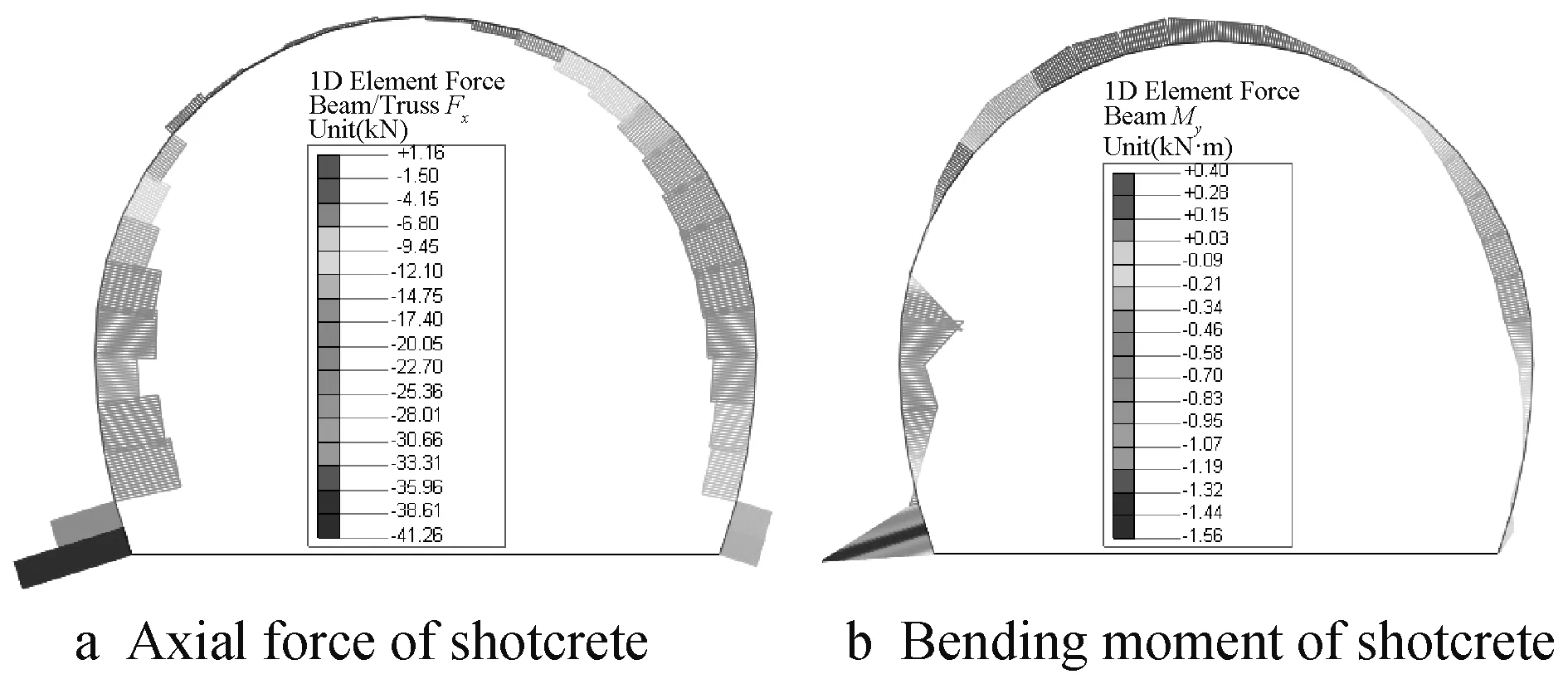
Fig.4 Force of shotcrete
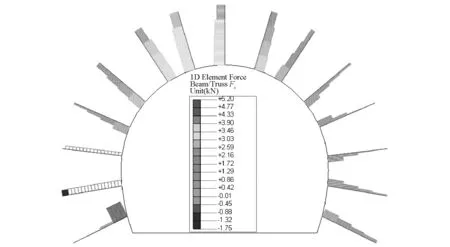
Fig.5 Axial force of bolts (unit: kN)
The first primary stress of the concrete secondary lining, which is trensile stress, reaches a maximum value of 0.018MPa at the outer edge of 1.2m on the left side of the concrete secondary lining near the arch roof. The third primary stress, which is compressive stress, has a maximum value of -0.873MPa towards the lower left wall(as shown in Fig.6).
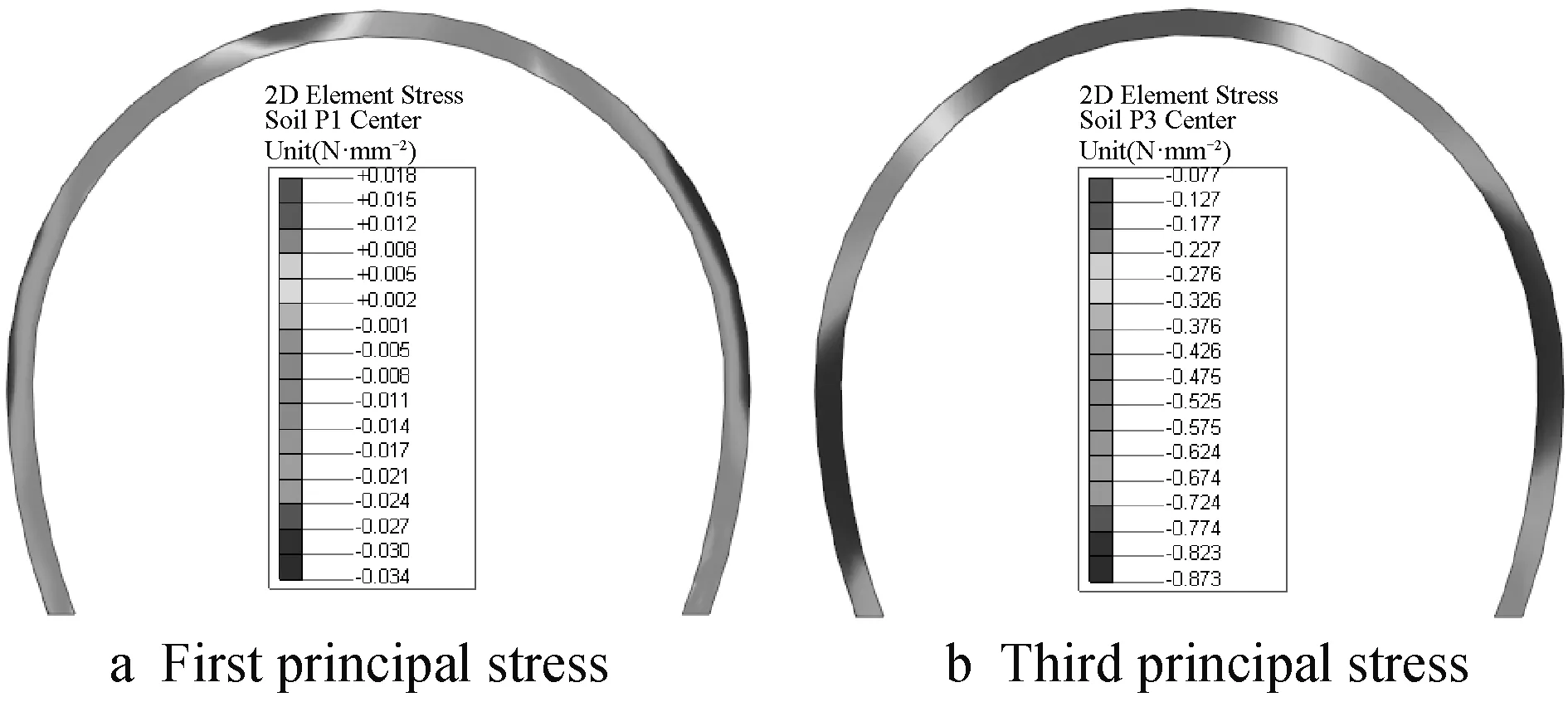
Fig.6 Stress of concrete secondary lining (unit: MPa)
3.2 Support structure strength and deformation checking calculation
3.2.1Strength checking calculation of shotcrete structure
This calculation of the shotcrete structure can be regarded as a rectangular section of concrete axis or eccentric compression components, with sectional strength assessed according to the damage stage. According to the bending moment value, the maximum axial force of the shotcrete structure is -41.26kN, the corresponding eccentricitye0is 37.81mm, and the section thickness of the shotcrete structure in the design is 0.1m.
According to the relevant provisions ofSpecificationsforDesignofHighwayTunnels(JTG 3 370.1-2018)[8], concrete rectangular section components can be tested as follows:
(1)
WhereKis the safety factor(K=2.4),Nis the axial force,Rlis ultimate tensile strength of concrete (the tensile strength of C20 shotcrete is adopted),bis the width of section ,andhis the thickness of section.
The following formula is used to determine the strength of the shotcrete structure:
It can be seen that the shotcrete structure can meet the required strength.
3.2.2Strength assessment calculation of the concrete secondary lining structure
The composite lining, which combines shotcrete and concrete secondary lining, is used to the traffic tunnel support. In the calculation model, concrete secondary lining structure is treated as a plane strain element and its stress state is calculated. The sectional strength of concrete secondary lining structure is determined as follows:
σmax<[σ]
(2)
Whereσmaxis the maximum stress on the section of the secondary lining concrete, and [σ] is the allowable stress of concrete structure (MPa) .
Based on the calculation results, the maximum tensile stress of concrete secondary lining structure is 0.018MPa, which is less than the allowable tensile stress of C25 concrete of 0.5MPa. The maximum compressive stress of secondary lining is 0.873MPa, which is lower than the allowable compressive stress of C25 concrete of 9.6MPa. Obviously, the secondary lining structure’s tensile and compressive stresses can meet the safety requirements of sectional strength.
3.2.3Verifying the deformation calculation
The net calculated span of the traffic tunnel is 8.85m. According to theSpecificationsforDesignofHighwayTunnels(JTG 3 370.1—2018)[8], the allowable deformation of the lining structure isl0/400 (l0is the net calculated span of the structure). Based on the numerical calculation results, the maximum deformation of the secondary lining structure is 1.18mm, which is significantly less than the allowable deformation value of 22.13mm. Obviously, the deformation of the secondary lining structure meets the requirements of safety and stability.
4 Conclusions
In this paper, the author uses the finite element method, selects the typical traffic tunnel section, builds the numerical calculation model, simulates the excavation and support construction process of traffic tunnel, and then analyzes the deformation of surrounding rock as well as the stress of shotcrete-bolt support structure and secondary lining. The following are the primary conclusions.
1)After the excavation of the traffic tunnel, the unloading rebound deformation of the arch roof and the bottom plate dominate surrounding rock deformation. The maximum overall displacement is 1.32mm, which occurs at the bottom plate, with tiny surrounding rock deformation. Despite the weak structural plane, the surrounding rock is stable. The surrounding rock has sufficient self-bearing capacity to meet the deformation stability requirement of excavation.
2)The stress of shotcrete and bolts in initial support can meet the requirements of strength and stability, and the shotcrete-bolt structure primarily serves to sea local cracks and beautify the tunnel wall.
3)The secondary lining of the traffic tunnel has the maximum tensile stress and compressive stresses of 0.018,0.873MPa, respectively. The stress of the secondary lining is low, which can meet the strength requirements of the structure.
4)The numerical simulation results demonstrate that the structural parameters of shotcrete-bolt structure and secondary lining used in the traffic tunnel design can meet the requirements of the traffic tunnel’s strength and deformation stability with a safety margin. The traffic tunnel’s support design can be further optimized based on findings of numerical calculation and analysis.

